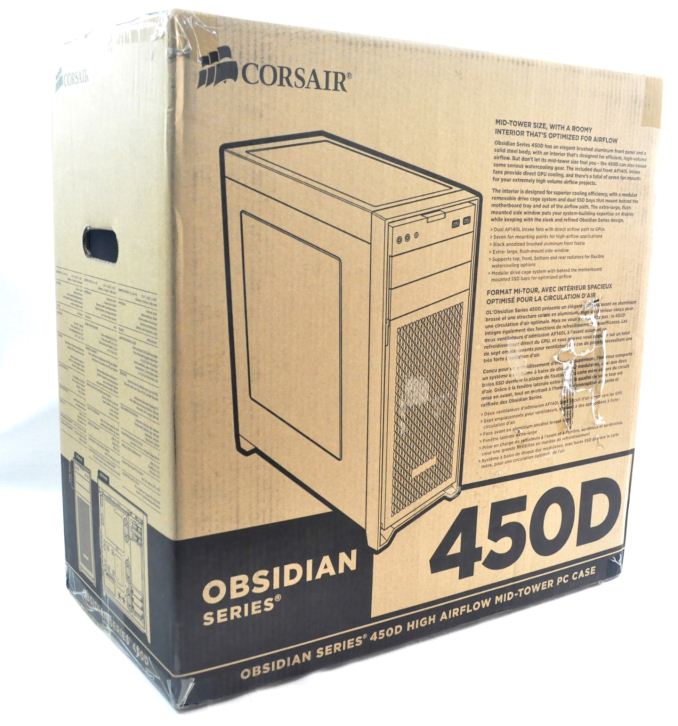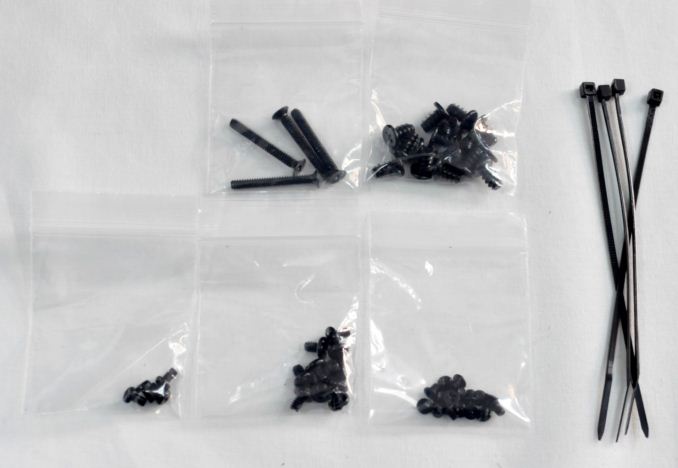Corsair Obsidian 450D Case Review
by E. Fylladitakis on April 4, 2014 6:00 AM EST- Posted in
- Cases/Cooling/PSUs
- Corsair
- mid-tower
- Case

Corsair Obsidian 450D: Introduction and Packaging
Corsair is a company that hardly requires an introduction; almost every PC user has heard of their name and a large number own at least one of their products. More advanced users know that Corsair is one of the oldest companies that's still around. The company was established in 1994 as a cache module manufacturer but their focus changed to DRAM modules a few years later. Corsair began a very aggressive diversification scheme over the past decade, which turned the DRAM manufacturer into a giant that markets several dozen technology-related products, their four series of cases being among the most popular of them.
Depite having over a dozen designs available, Corsair is continuously releasing new cases to enrich their product ranks. It's only been a few months since the release of the Obsidian 250D, a cubic Mini-ITX case, and today yet another product joins the ranks of the Obsidian series. In this review, we'll look at Corsair's newest mid-tower case, the Obsidian 450D, a case designed to bridge the gap between the Micro-ATX Obsidian 350D and the towering Obsidian 750D.
| Corsair Obsidian 450D Specifications | ||
| Motherboard Form Factor | ATX, Micro-ATX, Mini-ITX | |
| Drive Bays | External | 2 x 5.25" |
| Internal |
3 x 2.5"/3.5" (front drive cage) 3 x 2.5"/3.5" (optional front drive cage) 2 x 2.5" (rear of motherboard tray) |
|
| Cooling | Front | 2 x 120 / 140mm (2 x 140mm included) |
| Rear | 1 x 120mm (included) | |
| Top | 3 x 120mm or 2 x 140mm (optional) | |
| Left Side | - | |
| Bottom | optional 2 x 120 (drive cage has to be removed or relocated) | |
| Radiator Support | Front | Up to 240mm / 280mm |
| Rear | 120mm | |
| Top | Up to 360mm / 280mm | |
| Side | - | |
| Bottom | 240mm | |
| I/O Port | 2x USB 3.0, 1x Headphone, 1x Mic | |
| Power Supply Size | ATX | |
| Clearances | HSF | 165mm |
| PSU | Any | |
| GPU | 430mm | |
| Dimensions |
494mm × 210mm × 497mm (H×W×D) 19.5 in × 8.3 in × 19.6 in (H×W×D) |
|
| Prominent Features |
Tool-free 2.5” drive sleds behind motherboard tray 360mm radiator support with removable magnetic filter Removable 3.5” drive cage allows use of 240mm bottom radiator Up to 280mm radiator support in front. |
|
| Price | $119 USD (MSRP) | |
The Obsidian 450D comes in a rather simple, brown cardboard box. The artwork is limited to a basic schematic of the case itself. Inside the box is the case protected by Styrofoam slabs and wrapped in a nylon bag, which should offer ample shipping protection for a typical ATX case.
Alongside with the Obsidian 450D, Corsair supplies only the bare essentials. We only found a handful of black screws and a few cable ties supplied with our sample, as well as a basic installation guide. Considering the class of the Obsidian series, the bundle leaves a lot to be desired -- nicer velcro wraps would be appreciated as an example.












36 Comments
View All Comments
Communism - Friday, April 4, 2014 - link
Please use comparison tables/graphs of some sort (to compare them to the other cases you have reviewed), as these results are basically meaningless without them.Maybe do the tables/graphs comparing the temperature of each component at the longest time measurement the is common between each of the cases tested.
Communism - Friday, April 4, 2014 - link
Maybe start a "Case 2014" in "Bench"http://www.anandtech.com/bench/Cases/742
And put a link to it in each section of your results corresponding to the "Bench" entry you are talking about.
UltraWide - Friday, April 4, 2014 - link
This is actually a great idea!E.Fyll - Friday, April 4, 2014 - link
We just have too few samples right now. A database will be created once there are at least a few reviews of each type of case available.just4U - Friday, April 4, 2014 - link
Is that your new test PSU for builds, or is it just going to be used for Corsair stuff? It's a good power supply for getting a nice clean wiring job and makes things relatively easy for setup. btw, What extensions are those you are using? The red thingies.. is that a accessory from Corsair?poisonsnak - Saturday, April 5, 2014 - link
Corsair makes individually sleeved cables. I couldn't get them to come up on corsair.com for some reason but I found a blue kit on NCIX http://products.ncix.com/detail/corsair-profession...Black Obsidian - Friday, April 4, 2014 - link
It almost seems as though the 450D is the successor to the 650D. It basically trades the "old Corsair" design (fewer, larger fans, limited radiator support, full complement of drive cages) for the "new Corsair" design (lots of radiator support, and thus almost necessarily more, smaller fans, additional purchase to reach full complement of drive cages but 2.5" mounts behind the motherboard to compensate), shedding the fan controller in the process.And yet the point about the 650D costing nearly twice as much is a good one. Even as someone who owns and quite enjoys a 650D, I can't think of a good reason why that is. Sure, the extra drive cage and fan controller are handy, but not $100+ handy.
Also, E, although I know we don't (and are seemingly unlikely to ever) see eye-to-eye on the usefulness of your thermal testing method, I just wanted to say that I appreciate how you've been adapting your reviews to take into account other advice/requests, such depth measurements for the space behind the motherboard tray.
britjh22 - Friday, April 4, 2014 - link
I also appreciate the expanding of the articles based on feedback. Yesterday I left a comment on the Graphite 760T review (bottom of page 2 of comments), as I read it late, and I wonder if there would be any response? I think the discussion between E and Black Obsidian encapsulated many of the issues I have with the newer format, and I think there could be very interesting and informative articles to come out of it (investigation of how small component choices affect a testing situation, proving the new testing methodology is the way to go). Thanks for the articles E, keep it up, and thank you for considering the communities feedback!E.Fyll - Friday, April 4, 2014 - link
My apologies, I rarely keep track of the review comments after a day or two that the review has been published; otherwise I would not have the time to do any real work.I thoroughly explained that there is no "real world" testing that can be considered testing at all and stated the most important reasons. You cannot possibly correlate test results between different systems, not even if the system is an exact copy of your own. Even a different thermal paste on the CPU can alter the temperature by up to five degrees Celsius, let alone a different cooler and or component. Even worse, a single change of a BIOS setting from "quiet" to "performance" can drop a full-load temperature measurement by a dozen degrees. If a single setting is capable of changing the results that much when the system is exactly the same, that is proof enough that "real world" testing has nothing "real" about it and zero usefulness to the end reader. If you are making comparisons and correlations based on such tests, you are merely playing a guessing game; you can pretty much do that without any "real world test results" given to you, therefore such data have been useless to begin with and there was no point in doing any kind of testing.
When you want to test the thermal performance of anything, you add a constant and passive load to it, so as to have minimal variables to worry about and force the test subject to cope with the load by itself, unaided by external factors. Using an unknown, unstable and active load does not even qualify as testing by any kind of standard, it is just plain wrong. The very idea of doing "tests" that the reader will be expected to guess (!) the "correlation" of our results to what he/she expects from another system turns my stomach upside down. Instead of doing any kind of such useless testing, I would rather not do it at all and focus on the real factors that make cases sell; quality, functionality and aesthetics. (Come on, no one would buy a case that they do not like over one that they do like for a difference of even several degrees, let alone a couple at most)
I think that pretty much covers about everything.
britjh22 - Friday, April 4, 2014 - link
My main issue continues to be that this type (synthetic) of testing doesn't seem to be any more valuable for a buying/recommendation standpoint. It gives a very repeatable, scientific look at how a case can dissipate 850W of heat. However, how many readers are going to be buying this case to install a 850W heat generator, I'd guess not many.You alluded to the potentially significant difference one component being changed can make. If that is the case, what use are these tests to consumers. If buyers are looking at data comparatively (which I assume is the goal once enough cases have been run through these tests, readers are already requesting it), this data may lead to an incorrect judgement based on what is being installed.
I would love to see an article exploring different components effects on outcomes, and I understand your logic and reasoning regarding your testing methodology. However if the data is no more useful for making a buying decision, the better test isn't any more helpful from a reader's perspective. I would like to think there is a better conclusion then "there is no useful objective test because of system variability", but perhaps that is the answer.